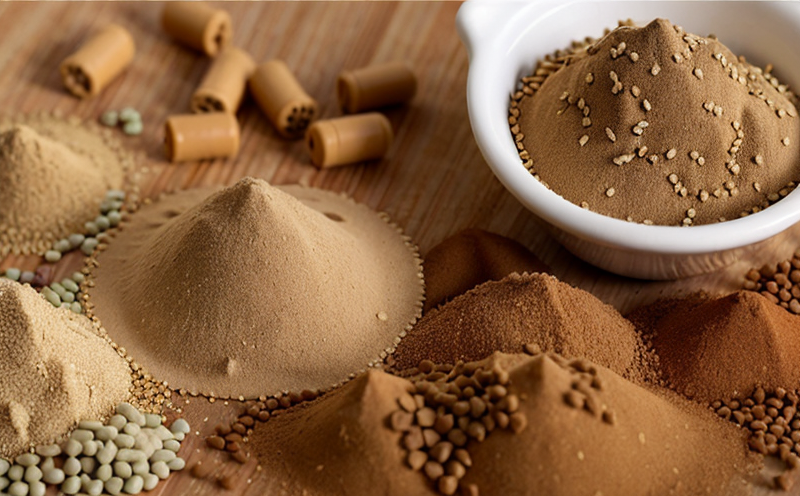Ractopamine Residue Testing in Animal Feed
Monitoring ractopamine residues in animal feed is critical for maintaining food safety and compliance with international standards. Ractopamine, a beta-adrenergic agonist used to promote growth and efficiency of livestock, can accumulate in feed products if not properly managed. This accumulation poses potential health risks to consumers who consume meat from treated animals.
The testing process for ractopamine residues involves several steps, starting with the collection and preparation of samples from various sources within the animal feed supply chain. Samples must be representative and free from contamination to ensure accurate results. Proper sample handling is crucial to prevent degradation or introduction of contaminants that could affect test outcomes.
Instrumentation plays a pivotal role in this testing process, with advanced analytical techniques such as Liquid Chromatography-Mass Spectrometry (LC-MS) being the gold standard for detecting ractopamine residues. LC-MS provides high sensitivity and specificity, making it ideal for identifying trace amounts of ractopamine even at very low levels.
Following sample preparation, the analytical method must adhere to international standards such as ISO 17025 for laboratory accreditation and ISO/IEC 17026 for proficiency testing. These standards ensure that the testing process is reliable and reproducible across different laboratories. The acceptance criteria for ractopamine residue levels are typically set by regulatory bodies like the World Organization for Animal Health (OIE) and the United States Food and Drug Administration (FDA).
The OIE recommends a maximum limit of 10 parts per billion (ppb) or micrograms per kilogram (µg/kg) in animal feed. Compliance with these limits is mandatory to ensure that no adverse effects are caused to consumers who consume meat from treated animals.
For quality managers and compliance officers, understanding the intricacies of ractopamine residue testing can help them implement effective monitoring programs within their organizations. R&D engineers can benefit by staying updated on the latest analytical methods and instrumentation that enhance accuracy and precision in residue detection. Procurement professionals will find this service valuable as they ensure that only compliant feed ingredients are sourced.
- Sample Collection: Ensuring representative samples from various points within the supply chain to avoid bias.
- Preparation: Proper handling and processing of collected samples for accurate analysis.
- Analytical Method: Use of LC-MS for high sensitivity and specificity in detecting ractopamine residues.
Applied Standards
The testing of ractopamine residue in animal feed must comply with a variety of international standards to ensure accuracy, reliability, and consistency across different laboratories. The International Organization for Standardization (ISO) provides several relevant standards that guide the testing process:
- ISO 17025: General requirements for the competence of testing and calibration laboratories.
- ISO/IEC 17026: Requirements for proficiency testing organizations providing services to support conformity assessment.
- ISO 9001: Quality management systems that ensure consistent production, delivery, and monitoring of ractopamine residue testing results.
In addition to ISO standards, the American Society for Testing and Materials (ASTM) provides guidance in its documents like ASTM E2587-14a on methods for determining the presence of ractopamine. The European Committee for Standardization (CEN) also publishes relevant standards such as EN ISO/IEC 17025:2017.
These standards ensure that laboratories adhere to best practices in sample preparation, analytical techniques, and reporting procedures. Compliance with these standards is essential for maintaining the credibility and integrity of testing results.
Customer Impact and Satisfaction
The impact of accurate ractopamine residue testing on customers cannot be overstated. For quality managers, compliance officers, R&D engineers, and procurement professionals, the ability to detect even trace amounts of ractopamine ensures that only safe and compliant products reach the market.
- Quality Managers: Reduced risk of contamination in feed products, enhancing product integrity.
- Compliance Officers: Assurance of regulatory compliance to avoid costly fines and reputational damage.
- R&D Engineers: Continuous improvement in feed formulations without compromising on safety or efficacy.
- Procurement Professionals: Secure sourcing of raw materials that meet stringent quality standards.
Customer satisfaction is paramount, and accurate testing not only meets regulatory requirements but also enhances the reputation of suppliers and manufacturers. By providing reliable test results, we contribute to a safer food supply chain, ultimately benefiting end consumers.
International Acceptance and Recognition
Ractopamine residue testing is widely recognized across international borders for its role in ensuring food safety. Regulatory bodies such as the OIE and FDA have established guidelines that are consistently followed globally:
- OIE Guidelines: Recommend a maximum limit of 10 ppb or µg/kg in animal feed.
- FDA Regulations: Similar to OIE, with strict enforcement measures for non-compliance.
The acceptance and recognition of these standards by countries worldwide underscore the importance of adhering to them. Laboratories that meet these standards are often preferred by international buyers due to their commitment to quality and safety. This recognition also facilitates smoother trade between nations, as there is a common understanding regarding residue limits.





